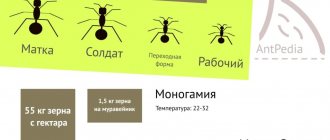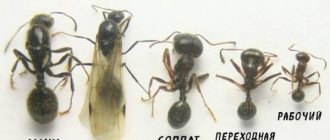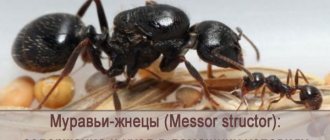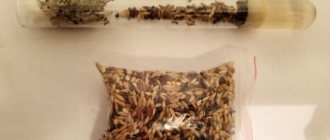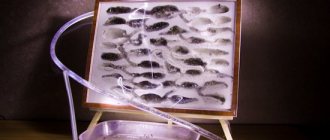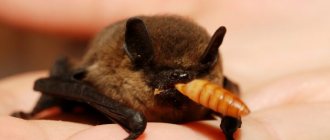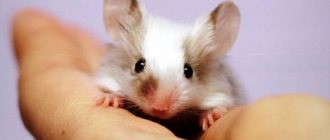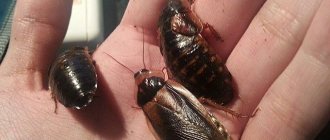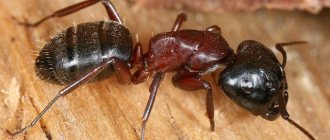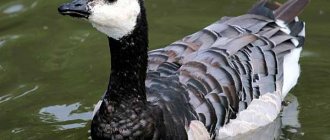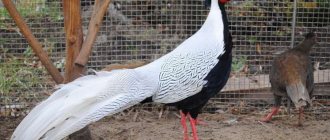Hello! Today the main character of the article is steppe harvester ants (Messor constructor) . I'll tell you about maintenance, care, what to feed, and how to moisturize. My journey as a keeper began with harvester ants, because the species does not require care. Still, there are factors due to which the colony is doomed, so read the material to the end to save nerves, time and the life of your pets.
small infographic from me)
Ant and anthill
Polymorphism is well developed in these ant families.
Here you can find not only workers, soldiers, nannies, but also several transitional forms. This diversity is due to the fact that most plant grains are too large and hard for ants. Reaper soldiers have very large heads, not only for fighting opponents in duels, but also because these jaws are necessary for the primary crushing of grains.
People primarily encounter worker foraging ants, which disperse over long distances in search of food sources. You can only meet big-headed soldiers near an anthill. Insect families have very strict discipline. Here everyone behaves in accordance with the function that the community needs so much.
Reaper families are small: only about 5 thousand individuals in a developed anthill. You can't build a big house with that amount. Reaper nests do not have the dome familiar to the human eye. Among a flat surface, such an anthill can only be recognized by a small earthen mound with characteristic debris accompanying the transportation of seeds.
The main room is a long, almost vertically descending tunnel. Moves with cameras extend from it in different directions. In large anthills, 2-3 such sections are usually formed, small anthills get by with one.
Larval development
Individuals take care of the eggs, move them to separate chambers, and ensure that favorable conditions are maintained. Division into castes occurs already during the hatching of the larvae. Which of them will be who in society depends on the amount of food consumed.
The larvae are not able to move or eat independently. All this is provided by breadwinners and caregivers. The young are constantly increasing in size and pupate after 1-2 months. The pupa does not have a dense shell; the development of insects can be monitored. At the last stage, it begins to move and a full-fledged insect appears.
Who eats ants?
Many animals eat ants. Bears love to destroy the anthill, getting to the larvae of forest ants. Often anthills and wild boars are torn apart. Frogs, toads, wasps, lizards, antlions (insects of the order Netoptera), moles and hedgehogs eat ants of various types, including those living in the ground and trees.
Many birds value ants for their taste and nutritional qualities. Woodpeckers are especially active in destroying these insects, and during the swarming period (when the ants develop wings), they are attacked by swallows, swifts and dragonflies.
In warm countries, the natural enemies of ants are anteaters, aardvarks and armadillos, as well as some tribes of people who eat insects and their larvae as food. Some species of ants are attacked by other ants, and in times of famine, ants of the same species can eat each other.
On video: Ants drag sausage.
Regarding these insects, it is impossible to give a definite answer about what ants eat in nature or in the house in winter. Small pests are able to feed on dry leaves, tree sap, bread crumbs or dead flies at the same time. In an apartment, this insect can find any type of food, because even crumbs of bread, drops of butter and spilled sugar attract them. The pest is capable of even the smallest food crumbs, so a person should thoroughly clean his home and do cleaning, especially in winter.
OUR READERS RECOMMEND!
In the fight against ants, our readers recommend the Pest-Reject repeller. Electromagnetic and ultrasonic technology is 100% effective against ants, cockroaches, bedbugs and other insects. Absolutely safe, environmentally friendly product for humans and pets.
What do ants eat at home?
In the wild, small black or red pests like to feed on carrion. In winter, its share in the diet increases as plant products become less available. Typically in nature they eat fallen leaves, plant and tree sap, and the bodies of insects and other pests.
What does the queen ant eat?
Little black and other pests eat food in winter and at any time of the year depending on their position in the anthill. The queen in nature and in the house prefers protein foods. Often this is food of animal origin, for example, the remains of insects or large animals, small flies that live even in winter, dairy derivatives, human food and animal eggs. This is how black and red matki eat, in winter and all year round.
What do ant larvae eat?
Small larvae eat mainly light carbohydrate foods. This could be a plant, a mushroom, the juices of herbs and trees, or small insects. In the apartment, black and other small ant larvae feed on sugary dishes and ingredients, jam and honey. In some cases, they even eat larvae from other anthills.
Life of ants
Due to the huge number of species, the life of these insects has a direct impact on biogenesis. By forming anthills, they intensively loosen the soil, the roots of the plants are saturated with moisture and oxygen. At the same time, ants nourish the soil with various useful substances.
Diet
Each type of ant has its own feeding characteristics, so it is simply impossible to single out specific food. Insects feed on food items of animal or plant origin.
For proper development of larvae, protein is needed, the main source of which is dead insects, the remains of various animals and partially digested food left over from the imago.
House ants feed on gelatin, various dairy products, or leftovers from egg dishes. The queen eats protein food supplied by the individuals who care for her. Carbohydrates are obtained from honeydew and the fluid secreted by aphids.
What does the ant “menu” in nature consist of:
- Nuts, seeds and juices of green plants are the basis of the diet.
- Some species breed entire colonies of mushrooms in their own nests.
- Various insects with caterpillars are also included in the diet.
- The menu of harvester ants includes dry fruits, various seeds, and grain crops. About a kilogram of nutritious food is prepared for the winter period - this is enough for the whole family.
- Leaf-cutter ants feed on leaves, storing them for the winter. The leaves are chewed and stored in this form in special chambers. After some time, mushrooms appear on them, which become food for the whole family.
- House ants are omnivores and can easily profit from a variety of foods, including food waste.
How does the reproduction process occur?
Reproduction occurs 2 times a year in two different ways:
- The female leaves her family, taking several workers. She then forms a new family.
- The female goes on a mating flight, where she is fertilized by males living in another anthill. After fertilization, the female lays eggs, and when they mature, a group of worker ants is formed. While waiting for new workers to mature, the queen feeds on the remains of her own wings.
Insect development
Ants go through several stages of development - an egg, from which a larva hatches, and a pupa, which turns into an imago or adult. The queen mates only once in her entire life. The sperm obtained from the male is used by the female throughout the entire period.
Stages of ant development:
- The queen lays eggs, from which larvae emerge. Since they practically do not move, workers are responsible for their nutrition. There are four stages of molting, after which the larva stops feeding.
- By excreting the contents of its own intestines, it becomes a pupa.
- After completing the pupal stage, other individuals help the former larva emerge from the cocoon, since the young ant cannot do this on its own.
You can see how an ant develops in the following video:
Where do they live?
Ants are found on all continents. Insects live in different climatic zones. They are found not only in mid-latitudes, but also in deserts, as well as Antarctica and the Arctic.
Often ant nests can be found in the ground, rotten wood, under various objects that lie on the soil. There are species that do not build homes, preferring to attack and capture others.
Construction of an anthill
Most species are engaged in the construction of complex and large nests, but there are also those who lead a nomadic lifestyle and do not organize permanent housing. There are both underground anthills and tree houses.
During construction, soil, plant matter that is carefully selected, and many other “building” materials are used. Complex nests necessarily consist of a structure that ensures constant and optimal ventilation, air humidity and other important indicators.
You can see how ants build an anthill in the following video:
Lifestyle and nutrition of insects
As mentioned earlier, the most dangerous ants in the world are rightly called killers. These insects can not only lead to the death of an animal, but also a person, especially for those who suffer from a tendency to allergic reactions.
Each of these ants leads a specific lifestyle and eats completely differently. For example, harvester ants are herbivorous insects that feed mainly on cereals and grains. Currently, about ten varieties of these ants are known in nature, five of which can be found in Russia.
These insects live in special nests, which they build independently at a depth of about ten meters. They are mainly active at night. A special feature of these ants is that they collect grains from the ground without injuring the growing ear at all.
In their anthills, harvester ants build special grain storage chambers
As for fire ants, they prefer to live exclusively in warm environments closer to agricultural land. Ants live in nests and can also hide in underground passages at a depth of about one meter. Insects feed exclusively on pests that attack crops such as rice, legumes and sugar cane, as well as larvae, shoots and plant stems.
Yellow killer ants can only be found in the US state of Arizona. This ant is considered very dangerous as it can cause death with just one bite.
Arizona yellow ant
The bullet ant is a rather dangerous insect and has an impressive size. This insect lives in South America. These insects prefer to live in small colonies in nests that are built at the base of tree trunks and, in some cases, directly on them.
The bullet ant prefers to forage for food in the dark. Ants feed mainly on insects, both living and dead, as well as tree sap.
African siafu killer ants prefer to live in the tropical forests of the African continent. For their habitat, these insects build anthills, which are formed by interlocking the limbs of insects. In the middle of such an anthill sits the queen. These insects are distinguished by the fact that they can roam freely for up to ten days, after which they set up camp. These ants feed on absolutely everything that comes their way. It could even be snakes, frogs, birds, as well as various nests.
Nomadic army ant - siafu
Description
The length of working ants is about 8 mm. The main color is reddish and reddish-brown, to brownish-black. The antennae are 12-segmented, at the end with a club of 4 segments. The frontal area is grooved. Morphologically similar to Aphaenogaster
, but
Novomessor
differs from it: 1) (it is weaker than that of
Aphaenogaster
);
2) the structure of the postpetiole (it is not narrowed at the abdomen), which even brings them closer to the genus Veromessor
than to
Aphaenogaster
;
3) Novomessor
longer metathorax propodeal spines;
4) Novomessor
a grooved frontal area and is generally larger in size. There are other differences between taxa (genetic, ethological and environmental).
Brief information
Name in Latin: Messor structor Difficulty: for beginners Size of individuals: M - workers from 4 to 9 mm, soldiers up to 11 mm, queen up to 12 mm Size of colonies: up to 5,000 individuals Habitat: steppes and semi-deserts, from Portugal to Kazakhstan, and south to Iran Temperature: 23-25 degrees, preferably warmed up Humidity: gradient, from 30% in the arena to 90% in the nest Diet: plant seeds, dead insects Wintering: not required
Pheromones in the life of insects
An important role in the life of insects is played by glands that secrete various substances; with the help of some, for example, pheromones, they communicate. For example, foragers fix the food they discover with the help of pheromones, and mark the road until all the food ends up in the anthill (as soon as this happens, they stop marking the road with pheromones, and the smell dissipates).
This method allows the ants to cope with unexpected obstacles: if an obstacle suddenly appears on the way, the foragers begin their work. Having found a new path, they mark the road to the anthill, and its relatives begin their journey along the laid route.
Another interesting fact about the ant is its ability, with the help of pheromones, to communicate about the family during the exchange of food (what it currently needs, for example, what kind of food or the need for work in the nest).
Also speaking about the ant, it should be borne in mind that each of them has glands that they use for defense and attack (they are poisonous and almost all species have a sting). For example, some glands produce an acidic secretion, while many of the poisons they produce are characterized by the presence of complex compounds in combination with allergenic proteins. If a black worker ant finds itself in trouble, in order to protect the nest, it commits suicide: as a result of a specific muscle contraction, its abdomen ruptures and the secretion of the gland, which contains substances that glue the enemy, is sprayed out in all directions.
Physical signals
Naturally, insects can communicate with each other not only with the help of pheromones, but also with sounds (some species chirp using abdominal segments), as well as touches (for example, begging for food). There are two opposing opinions: some scientists are convinced that they are absolutely deaf, others categorically disagree with this.
However, it is known for sure that insects sense the vibration of solid bodies very well, and some species definitely make sounds while at the pupal stage. For example, a black ant that has not yet been born communicates its social status to working nannies.
Larval development
Individuals take care of the eggs, move them to separate chambers, and ensure that favorable conditions are maintained. Division into castes occurs already during the hatching of the larvae. Which of them will be who in society depends on the amount of food consumed.
The larvae are not able to move or eat independently. All this is provided by breadwinners and caregivers. The young are constantly increasing in size and pupate after 1-2 months. The pupa does not have a dense shell; the development of insects can be monitored. At the last stage, it begins to move and a full-fledged insect appears.
Read with this
Feeding of house and garden ants
Ants eat almost everything at home. They are ways to find food even in the cleanest and most tidy apartment: pick up any bread crumb, small sugar or drop of butter.
When settling in human housing, an indoor ant eats a wide variety of food, literally everything that is in an apartment or house: bread, various cereals, sweets, dairy and meat products, sausages and even spices.
In addition to small insects, black garden ants also eat secretions from farmed aphids. They specially plant aphids on plants in the garden and vegetable garden, carefully taking care of their “farm”, protecting them from other pests and from negative weather conditions. To drink the sweet honeydew secreted by the aphids, the ant tickles it, which causes a drop of juice to appear, which the “shepherd” drinks.
Ants in nature and in human habitation eat completely different food that they can find, and also depending on their position in the anthill: the best food always goes to the growing larvae and senior larvae.
https://youtube.com/watch?v=iJ-KL5oabCI
Reaper ant bites
It is known that reapers are peace-loving insects, and for no apparent reason they will not be the first to attack. But if an external stimulus appears or the anthill is in danger, the ants immediately rush to attack. The bite causes a burning sensation and the bite site becomes very swollen. Sometimes allergic reactions of the body to the venom of the reapers are possible.
Gypsum farm
To create an anthill, take a transparent container, then dilute the plaster to a thick sour cream. Pour the composition into a transparent plastic container, placing a plastic straw at the side. This is necessary in order to then add water to the plaster to maintain humidity in the formicarium.
The workpiece dries completely in about a week. After three to four days after pouring, remove it from the mold. To make the plaster come out easily, immerse it in hot (not boiling water) water for thirty seconds.
Now show your creativity - draw passages and rooms on the plaster. The composition is still raw, so it will not be difficult for you to scratch out any tunnels.
Drill an entrance for future residents of the farm using a drill. Take any tool convenient for you (stationery knife, screwdriver, etc.) and start making paths according to your design, choosing plaster from them
Proceed with caution so that the wet mixture does not crumble.
Make indentations at the bottom of the formicarium to better distribute water and moisturize the anthill. Don't forget about the ventilation holes in the container. Drill them with a drill (0.5 mm diameter) in the lid and side walls.
After this, you need to thoroughly dry the gypsum base and place it back into the container. If it does not fit, soak the mold in hot water again for 30 seconds. Your anthill is ready to move in.
Video: harvester ant bite
https://youtube.com/watch?v=mnv0OVK0JK0
Sources
- https://vredinfo.ru/muravi/muravi-zhnecy-messor-structor
- https://domovod.guru/borba-s-vreditelyami/muravi/skolko-zhivet-muravey-zhnets.html
- https://muravdom.ru/help/kartochki-vidov/messor-structor-stepnye-muravi-zhnecy-soderzhanie-i-uxod-v-domashnix-usloviyax/
- https://aquarium-fish-home.ru/zhivotnye/messor-structor-stepnye-muravi-zhnecysoderzhanie-v-domashnix-usloviyax/.html
- https://kursi-floristiki.ru/muravi/skolko-zhivut-zhnecy.html
- https://KlopVred.ru/muravi/skolko-zhivut-muravi-v-muravinoj-ferme/
- https://dr-dez.ru/muravi/chem-kormit-zhnecov.html
What do ants eat in the apartment?
Once inside the apartment, small black insects actively begin searching for food. At first, you can meet several ant individuals who came for reconnaissance. After they find a food source, they will call a whole colony of workers who will drag everything they found into the anthill. At the same time, they happily eat both plant and animal foods.
Judging by what ants eat in nature and in an apartment in winter, you can easily get rid of them by cutting off all possible access to food.
What do ants eat at home?
During the warm season, small black ants try to stockpile as much food as possible for the winter. With the arrival of cold weather, they become even more active in their work. It is during this period that they can be found in the house in search of food. Despite the fact that ants can be called omnivores, they are very picky eaters, but at the same time quickly adapt to any food source. In modern conditions, they have even adapted to synthetic food products. Therefore, everything that the insects come across on the way rushes into the anthill.
What do ants eat in nature?
In the wild, small black or red ants feed on plant seeds, sweet tree sap, and the remains of other insects or animals. Once in fields or private gardens, the pest is capable of destroying part of the crop by eating holes in the fruit. For example, the harvester ant is found only on grain crops and destroys their seeds. The powerful jaws of this type of insect are capable of grinding even very hard parts of seeds so that the rest of the colony can eat it. Therefore, it is necessary to combat harmful insects before they appear in large numbers.
What does the queen ant eat?
All worker ants carry the food they find into the anthill in order to feed not only themselves in winter, but also the queen, who never crawls out. In order to fully develop and produce offspring, she needs a high-quality and varied diet. Therefore, the uterus mainly feeds on animal food, which is rich in proteins and microelements. Also suitable for its nutrition is wild mushroom, which is also rich in proteins.
What do ant larvae eat?
The larvae feed mainly on food of animal origin. Working ants bring them the remains of insects, aphids and eggs of other small pests. In order to grow and develop, larvae urgently need protein food, which contains a large number of essential microelements and vitamins. In case of malnutrition of such food, the larvae may not develop, and adult ants will eat them themselves.
Social significance for the colony
This factor begins to influence life expectancy immediately after birth. In the first days and weeks, young individuals perform work within the colony. At the beginning, this means maintaining the cleanliness of the anthill, caring for the larvae and eggs. As they grow older, most begin to take on more important roles and gradually begin to move beyond the anthill. A trend emerges here: the further the ant moves away from the colony, the more often it dies.
Therefore, among workers, foragers usually live the shortest. The lifespan of soldiers depends on the characteristics of the species. For nomadic and expansive species (constantly raiding other species of colonial insects), soldiers die more often than foragers. Representatives of the families Dorilina and Ecitonina swing from one place to another. Amazon ants constantly bring black and red ants to anthills to prey on larvae. Both of them have a high mortality rate among soldiers.
Organization of family life
All individuals of an anthill are members of the same family. They know their mother well, because while the only female lives and reproduces, the anthill also lives. All family members, of course, once had a father. It’s just that the fate of the males of all anthills is the same: having fulfilled their function, die. And they have one function - to be a keeper and carrier of genetic information.
Harvester ants usually have one queen. At the time the nest is founded there may be several of them. The fate of each female depends on how quickly and in what quantity she produces offspring. Worker ants from one of the queens, gathered in a crowd, drive out all the other females. This is how the interests of the family are respected.
The specific structure of the reaper family lies not only in food preferences, but also in the rhythm of reproduction. The fact is that ants have 2 methods of reproduction: sexual and asexual. At a certain stage of development of the anthill, the female lays only those eggs from which asexual individuals emerge, divided according to professional specializations. However, there comes a time when males and females with wings are born from the eggs. At this moment, the so-called years of the ants begin. Individuals scatter in different directions, and those who survive mate and form a new anthill.
Typically, winged ants fly in the spring. Some may have observed such a massive phenomenon somewhere in the middle or end of May. During the summer period, these insects must have time to build a new anthill and prepare for winter.
The Reapers follow a slightly different strategy. Males and females appear in August, spend the winter in the parent anthill, and by the end of April they fly out to live independently. This winter “overexposure” of the founders of future anthills allows them to raise the first generation of worker ants much earlier than other species.
This extravagance of the parent anthill is associated with the conditions of arid zones. The early development of a new home occurs during the most favorable period in their rhythm - spring and the very beginning of summer. Then there will be a drought and the young anthill may die.
Gel farm
This is perhaps the case when this activity will be very interesting for children, and of course for adults as well. For such a farm you need a flat container that can be closed with a lid and gelatin. You need to take 3 bags of gelatin (15 grams each), pour 0.5 liters of hot water and stir well until the gelatin completely melts.
Next, we pour the mixture into a container, wait until it cools down and put it in the refrigerator until it hardens completely. We take it out of the refrigerator and wait until the gel reaches normal room temperature, and that’s it, the filler is ready. Remember that this filler is also food for goosebumps, so you don’t need to feed them.
Genus Messor – harvester ants
An article about harvester ants - peculiar, but very interesting ants. With their unusual appearance and calm character, they have won the sympathy of many Myrmikeepers, and their vitality and unpretentiousness make representatives of this genus simply an ideal choice as the first colony.
Description
Harvester ants are primarily interesting for their appearance - after all, most species of this genus are distinguished by their large size and beautiful large-headed soldiers - this feature is called polymorphism. The colony has a variety of forms of workers - from very small "nannies" who look after the brood, to large-headed soldiers whose job is to guard the nest and grind plant seeds.
Such a feature as polymorphism did not appear by chance, but due to dietary habits. For most representatives of this genus, feeding occurs as follows: first, worker ants transfer seeds to moist chambers, where the seeds begin to germinate. At this time, a biological process begins inside the seed - starch is broken down into simple sugars by enzymes. Once this process is started, the soldiers use their powerful jaws to grind the seeds, after which the workers mix the resulting flour with their saliva to obtain the so-called “ant bread” - a substance rich in carbohydrates and protein. It is this substance that feeds the entire colony - from the queen and larvae to the workers.
Habitat
Harvester ants live in steppe and desert areas where there is little rainfall and hot summers. In order to survive in such difficult conditions, ants store seeds, which are stored in the upper dry chambers of the anthill. Ants escape from lack of water by building long tunnels to groundwater. So, even during a long drought, they have access to moisture. In order not to suffer from the heat, ants go out to hunt in the evening, when the heat has subsided and it is safe to collect food. In nature, you can find various types of reapers, both in size and color, and in behavior.
In the tropical zone (China, India) there are several species of reapers that do not collect seeds and feed mainly on insects.
In Russia you can find Messor structor and denticulatus, in the south of Europe you can often see red-headed Messor barbarus and black Messor capitatus.
The habitat features of the reapers - namely the dry climate - led to the emergence of another feature, which is associated with flight. The fact is that in most species, flight occurs in mid-late summer - when the queens have time to grow from eggs laid at the beginning of summer. For reapers, the opposite is true - the queens, instead of flying at the end of summer, overwinter right in the anthill, and in the spring, with the first warm days, they set off on their mating flight. The explanation for this is simple - in spring the temperature in the steppes is more comfortable, and the soil is moister and softer, and the young queen can easily dig a nesting chamber for herself.
Behavior and activity
In general, reapers are a fairly calm and non-aggressive genus of ants. In nature, they never attack other anthills, they only defend their own feeding territory. They can lay quite long feeding roads and organize a multi-sectional nest. At home, as the colony grows, aggressiveness and activity increases, and if the arena is not large enough or the ants lack something (seeds or water), they begin to climb through the anti-escape, but overcome it very rarely and with great difficulty.
Care requirements
- Dry arena - ants will dry their seed reserves here
- Avoid low temperatures - ants are heat-loving and can suffer from sudden cold snaps. It is advisable to use additional heating for faster growth.
- The humidity gradient in the formicarium requires the presence of dry and wet chambers. Achieved through local hydration.
- Drinking bowl - it will serve as an indicator of the thirst of the colony. If ants crowd in large numbers around the drinking bowl, you need to moisten the formicarium. This is especially true for small colonies.
- Lighting – A heat lamp above the arena is desirable, but not required.
- Formicarium - any one that has local moisture is suitable, but due to the demands on the dry zone, collapses occur in the embankments, so it is better to use solid fillers.
- Wintering - a full wintering is not required, but to stimulate growth for several months a year, you should turn off the heating and stop feeding seeds, so that the family lives on seed reserves.
- Feeding - Most reaper species do not drink syrup. Moreover, the syrup can destroy a small colony - the ants can simply get poisoned.
Found an error in the material? Let us know!
What determines the lifespan of an ant?
The lifespan of ants, like cockroaches, varies greatly. This is mainly due to the following factors:
- Belonging to a specific species;
- Caste affiliation;
- Climatic living conditions.
The lifespan of an insect depends on caste:
- The shortest life expectancy is for ants that care for the queen and brood;
- Foragers and soldiers live a little longer, although they have a predisposition to longevity. But due to the fact that they are often attacked by predators and influenced by the environment, they die prematurely;
- The longest living insects, with the exception of the queen, are those living in the depths of the anthill.
Climatic conditions also have an impact on life expectancy. Insects that live in northern regions live longer because they go into hibernation during cold weather. Sometimes the hibernation period lasts 9 months.
Ants live in families (colonies) in anthill nests, which are built in the ground, wood, and under stones. Ants are organized creatures. A family (colony) is a complex structure with a clear division of responsibilities between its members.
Like all “social insects,” ants are divided into 3 castes:
- females (queens or queens). They lay eggs (males emerge from unfertilized eggs, females emerge from fertilized eggs). The queens have wings, which they chew off immediately after the mating flight. Female ants differ in size from other inhabitants of the anthill; they are much larger than males and worker ants. The queen is the only long-lived colony;
- males. Their only function is to participate in mating. Later they are destroyed by their own relatives from the anthill. Males are much smaller in size than females, but also have wings. Their lifespan is only a few weeks;
- worker ants (foragers). These are the same females, only with an underdeveloped reproductive system. The responsibilities of foragers include caring for the family, food and future offspring. They have no wings and are much smaller in size than the female. Large-sized workers are soldier ants (they have more developed jaws and a large head); they also perform all the duties of workers, but, among other things, protect their nest from attacks by enemies.
REFERENCE! Mating occurs in a female only once; the resulting sperm is enough for her to reproduce offspring throughout her life (10-20 years).
REFERENCE! Not all types of ants have a clear division into castes.
For example, garden black and pharaoh ants build a “career” for themselves: from birth they care for their offspring, then they arrange the anthill and only at the end of their lives they obtain food.
We suggest you read: Insects in the apartment due to dampness
What do harvester ants eat?
Particular attention should be paid to the feeding and extraction of food by the reapers. Since they most often feed on grain crops, it has long been believed that ants are agricultural pests
However, research has shown that insects only harvest crops that directly fall to the ground.
Reserves
The gathering of provisions is very interesting among the reapers. As stated earlier, the harvesting of grain occurs when it is on the ground. The workforce collects about 1.5 kg of grain crops from the fields in one season
Scientists have found that harvester ants send out workers as much as there is available food. If there is a lot of it, then the workers return faster and the number of ants sent for food increases. But if they return slowly, then the number of ants sent out decreases or stops altogether.
To store grain, hardworking reapers set up special rooms deep underground. In damp, warm rooms, the seeds begin to germinate, and as soon as the first sprouts and roots appear, the ants immediately destroy the shoots. After this, large soldier ants grind the grain into powder with their powerful jaws and, moistening it with saliva, feed this mixture to the larvae.
Features of feeding
At home, reapers eat sunflower, poppy or pumpkin seeds. In addition, you can take a canary mixture, the ingredients of which are cereals and seeds of various types of vegetation. You should not choose grain intended for sowing, since it is treated with special compounds that have a detrimental effect on ants - there is a risk of death.
You can purchase mealworms, cockroaches or crickets as protein foods. Please note that chicken meat and yolk also have a negative effect on insects.
To organize a drinking bowl for ants, buy a small test tube, then fill it with water and tightly close the hole with cotton wool - it will be moistened with water and will become an excellent source of liquid in the formicarium. Please note that the plug must be changed when dirty, as there is a risk of mold developing inside the farm.
Varieties of tropical killers
At this time, the most dangerous varieties of ants in the world are considered to be those that contain a fairly aggressive poison. These include:
- fire ants;
- yellow ants;
- bullet ant;
- bearded harvester ant;
- nomadic army ant - siafu;
- bulldog ant.
Bullet ants are considered one of the most dangerous, as they have very strong poison. Their bite simply causes unbearable pain, which accompanies the affected area throughout the day. The main habitat of such insects is the tropics and subtropics.
Another quite serious and dangerous ant for humans is considered to be the fire ant. The bite of this insect causes a severe allergic reaction in a person, which leads to the death of the person. The peculiarity of these ants is also that they easily adapt to completely unfamiliar territories. As for the bite of these insects, they feel more like pain from a burn, which in turn also provokes the formation of a tumor.
A fire ant bite causes a severe allergic reaction in humans.
Poisonous insects also include yellow ants, which can only be found in Arizona. After the bite of this insect, not only significant swelling appears on the surface of the body, but also a severe allergic reaction develops, which very often ends in death.
Bearded harvester ants are mainly distinguished by the fact that they do not cause any harm to agriculture at all, as they feed on cereals and grains. Among other things, these ants are completely safe for humans; on the contrary, they help destroy various pests in the fields.
Australia is home to another species of ants that pose a danger to human health. This is the nomadic army ant Siafu. The danger of this insect lies in the fact that it has quite powerful jaws, and its bites provoke the development of serious allergic reactions.
They'll definitely grow up
Having seen the larva of a leaf-cutter ant, the description of which you have already become familiar with, you would never say that it will grow into a strong ant. She looks like a little white worm. She has no eyes, no limbs, and without special care she will die. Moreover, for proper growth and development, it is necessary to monitor not only the correct feeding of the larvae, but also the conditions in which they are located. Air temperature and humidity must be maintained at a certain level. The ants feed the larvae with their own eggs, gradually transferring them to mushrooms. Interestingly, unfertilized eggs grow into males. Of the fertilized ones, there are females that will eventually become workers or queens.
Formicarium
The formacirium is a kind of terrarium where you can clearly see what the pets are doing. Such incubators differ in their display - level of observation. There are vertical, horizontal, and volumetric displays. It is allowed to combine them.
You should choose a filler - a material for the construction and development of an ant farm. This happens:
- gypsum is the most common filler in Russia;
- aerated concrete; this material is widely used in Europe;
- alabaster and cement;
- sand and clay;
- tree.
An important part of the formicarium is the arena, which imitates the above-ground life of insects. There is food there (if the owner, of course, took care), water, there is also a corner for garbage - usually the farthest
How to get rid of ants in an apartment forever
When small black ants get into an apartment or private house, they bring a lot of inconvenience to a person. During the mating season, adults are very aggressive and bite people, which leads to painful sensations. Working individuals are constantly crawling in the kitchen on all the products, but before that they could also actively crawl on the garbage bin. Therefore, it is better to get rid of them as quickly as possible, avoiding global reproduction.
Black ants, like other small insects, cannot tolerate the smell of certain herbs such as wormwood, mint and elderberry. Spread out plant branches will help repel pests in winter and prevent them from entering your living space. This needs to be done in advance, before their invasion appears, since such a folk recipe will help get rid of several individuals who ran in by chance, but not from a flock.
The most effective in the fight against ants are:
- aerosols and sprays, for example Raptor, Dichlorvos, Dichlorx;
- line of Combat products;
- ant baits and traps.
Folk remedies for ants in the apartment
In addition to modern chemicals, there are also traditional methods that have been proven for more than one generation and give good results in exterminating pests:
- since these insects eat everything sweet, special baits are prepared from sugar, hard yolk and boric acid, the prepared balls are laid out in places where they accumulate and move;
- coffee grounds mixed with honey or sugar syrup can destroy an entire ant family;
- cornmeal sprinkled with powdered sugar will also help in pest control.
In nature, there are many species of small ants, some can live only in the forest, feeding on wood, others eat only animal food, and still others look for food in all sorts of places, including apartments. They are the ones who come into our homes in winter in search of the food needed for normal existence.
Among the vast family of ants there are insects whose diet consists exclusively of plant or, conversely, animal food, as well as omnivores and species with very unusual food preferences. In addition, the diet of ants often changes dramatically after the transition from the larval stage to the adult, and also depends on the season of the year and the role that each ant performs in a large ant community: guarding the anthill, searching for and bringing food, caring for the growing juveniles and females, laying eggs.
Both in the wild and in a person’s home, insects with different types of nutrition can be found. In a human home, ants find a wide variety of food for themselves, no matter how hard a person tries to prevent it: for the survival of a colony, a few small crumbs of bread or grains of sugar that fell from the table to the floor, a drop of oil on a gas stove or smears of jam left on the edge of a jar are enough .
Some species of ants can even attack objects that seem unsuitable for food: watercolor and gouache paints, casein and bone glue, wood, paper. In fact, these and similar things consist of natural ingredients that are quite edible from the point of view of insects or suitable for building a nest.
Settling in gardens and vegetable gardens, ants eat berries, juice of fruits and vegetables, honey from bees, gum from tree trunks, as well as insects. The last fact, unlike all the others, testifies in favor of ants. Although, in general, most people assess the proximity to ants as unpleasant and make every effort to get rid of these insects in the house and on the land.
You can find reports from gardeners that in the spring ants even feed on young cabbage and tomato seedlings, although these are rather rare cases.
Ants know how to farm
This interesting feature of ants has been known for a long time - South American ones use the most complex food chain in the animal world:
some members of the colony bite off a large piece of a tree leaf and bring it to the anthill
- smaller individuals that never leave the colony chew the leaves, mix them with excrement and parts of a special mycelium
- the resulting mass is stored in special areas of the anthill - real beds - where mushrooms develop on it, providing the ants with protein food.
The interesting thing about ants is that they do not eat the fruiting bodies themselves - they feed on special growths of the mycelium. Some members of the colony constantly bite off the emerging fruiting bodies, preventing the mycelium from wasting nutrients on useless stems and caps.
Besides ants, only humans and termites have learned to cultivate other living organisms for their own benefit.
Complete transformation
In the anthill, life is vibrant and constantly renewed. Like any insect, this forest orderly goes through a series of transformations in its life. Moreover, the stages of his life differ significantly functionally and externally. There are four known stages of ant development:
- egg;
- larva;
- chrysalis;
- adult (imago).
That is, all varieties of ants belong to insects with a complete cycle of transformation, which is called holometaboly. As a rule, in most species the entire development process takes about a month.
